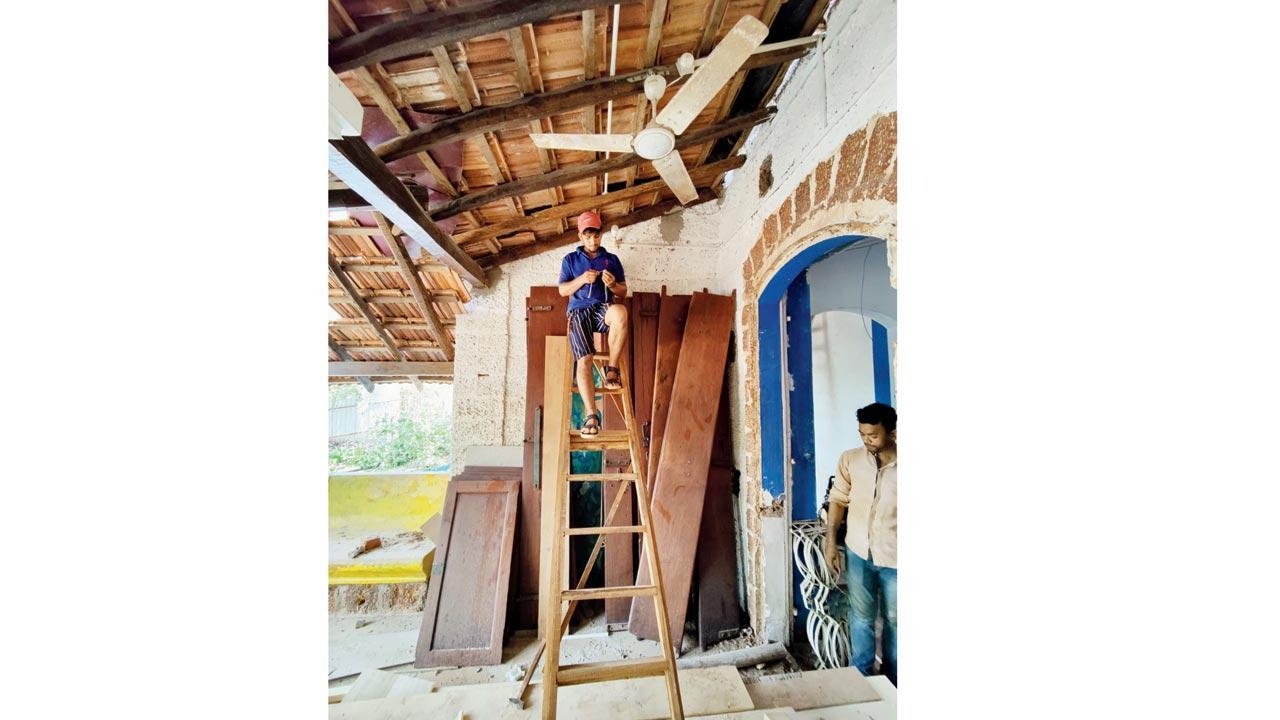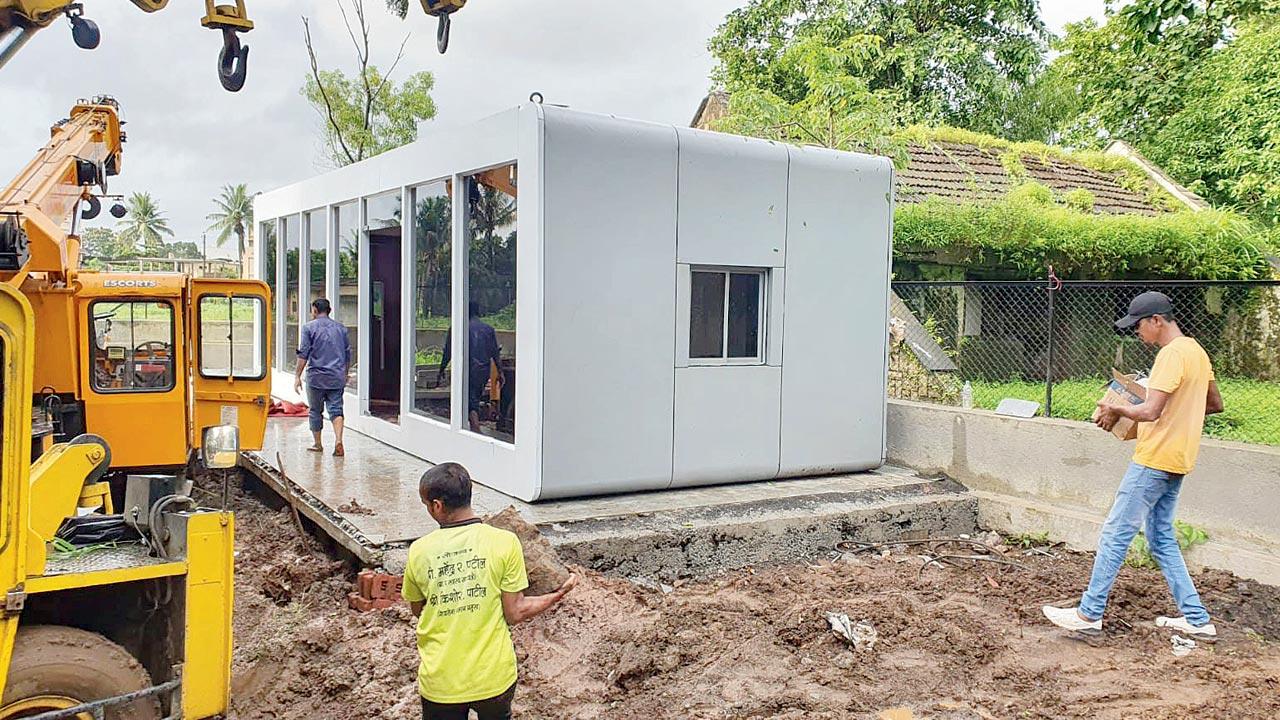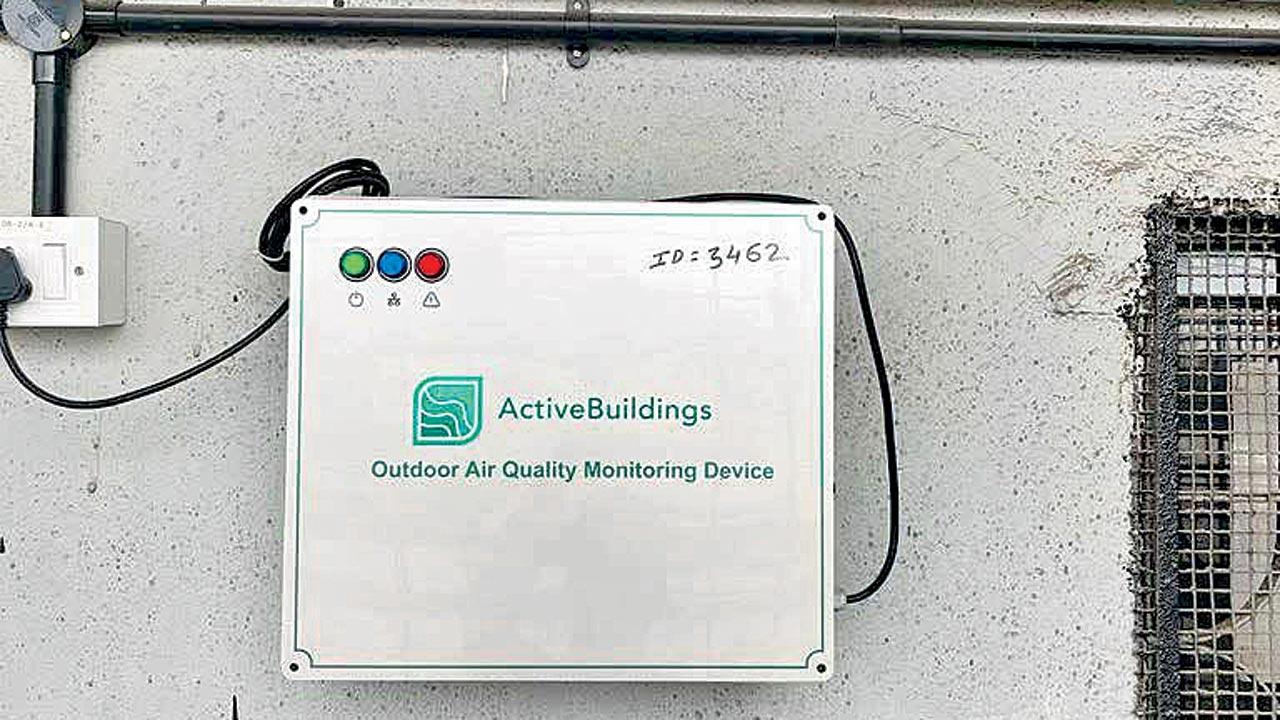Ahead of Environment Day tomorrow, we look at imaginative ideas that can help us survive the pollution caused by construction dust

Chira slabs (right) are made of compacted red mud found in the Konkan belt and are a substitute for marble
Finding it hard to breathe? Construction, with its constant generation of dust, is one of the biggest pollutants in the city currently. A 2020 study by National Environmental Engineering Research Institute (NEERI) and IIT-Bombay clearly pointed out that dust generated by construction work comprised 70 per cent of the particulate matter (PM) load in Mumbai’s air. In February, Mumbai’s air-quality was worse than Delhi’s, spurring activists to demand a halt of construction activities in the city.
In April, Thane Municipal Corporation (TMC) declared it would fine developers to the tune of '5,000 to 25,000 if they did not do anything to control the dust from construction sites. But how does one do that?
 The inside of the Olle Pod is swanky and is even equipped with designer toilet fittings
The inside of the Olle Pod is swanky and is even equipped with designer toilet fittings
Architect Keith Menon, co-founder of Spiro Spero and Circle in Goa, has a way out. The firm has built a 2.5 acre-resort in Goa, using chira stone mined from the property itself. “We dug the ground using techniques that would not crack the stone, so that we were able to get large slabs that could be assembled by binding,” he says, “As a result, air pollution was reduced by 30 per cent [as this reduced use of cement and concrete as well as cutting out of marble from mountains and transporting it to site].”
Chira is red mud compressed and compounded over 100 years, and is unique to the Konkan belt. It’s a worthy replacement for marble, as almost 20 to 30 per cent of the latter is wasted in the form of powder when it is cut into desired shapes. And this powder contains calcium carbonate and silica that lines lungs and decreases their capacity to filter air, causing pulmonary diseases.
 An Olle Pod being anchored to the Earth with cranes. It is 480 sq ft in total and can be transported anywhere
An Olle Pod being anchored to the Earth with cranes. It is 480 sq ft in total and can be transported anywhere
“We often take chira or any organic material found naturally on the project site and reuse it for the next project” says Menon. “We hope this creates a chain reaction that quells the effects of construction.”
Like Menon, Lavina Rodrigues too is trying to make a change in the way things are traditionally done. While working with the Navy, she invented Olle Pods that can replace concrete. “The pod has a pre-fabricated metal frame with walls made of calcium silicate panels,” says the Kharghar-based architect. “The 35 cm of wall and 30 cm of roof/floor is filled with mineral wool for highest level of thermal insulation, long-term stability, and durability. It is as reliable as concrete.” No concrete, no pollution.
 The outdoor sensor that can check the Air Quality in and around your home
The outdoor sensor that can check the Air Quality in and around your home
Olle Pods take up 480 sqft and Rodrigues is currently scouting for land to display them, and guarantees that their use will reduce construction time by 50 per cent, which will also contribute to reduction in air pollution. They can also be recycled. Rodrigues hopes this motivates people to move away from the use of Reinforced Concrete Cement (RCC).
What exactly are we breathing though? Abhinav Gupta’s company, Active Buildings, manufactures sensors that tell you about the air-quality within your home as well as the area around it. “Most of our customers are concerned parents or social activists,” says the Chandivili based engineer. “One parent placed a sensor in her child’s school at BKC, another in her Vile Parle neighbourhood and a social activist used it to assess the air around the Deonar dumpyard.” According to the report, the dumpyard predictably, had the worse readings, with the Ozone (O3) and Nitrous Oxide parameters in the ‘Bad’ category and are known to cause pulmonary ailments as well as decrease long term immunity.
 Abhinav Gupta
Abhinav Gupta
Homegrown innovators are on it, though. Such as Tejas Sidnal, founder of CarbonCraft, who reuses Recovered Carbon Black (RCB) (the powdered form of carbon) as tiles. “At first, we made bricks [out of RCB], but no one wanted to pay an extra four rupees for them,” he says. “So we moved on to tiles because people like beautiful tiles. We place our equipment on the chimney in say, a tyre company. The powdered carbon that is collected, which would line our lungs otherwise, is moulded into tiles. These have lined the floors and ceilings of offices of international brands such as Adidas, who want to reduce their carbon footprint.”
Internationally, checks and balances keep an eye on pollution generated by construction activity, and countries such as the United States incentivise use of less toxic raw materials or fuels and use of a less-polluting industrial process. Use of mechanical collectors, wet scrubbers, fabric filters (baghouses), and absorbers—all of which reduce emission of construction particles in the air—are encouraged.
 Keith Menon, Lavina Rodrigues and Tejas Sidnal
Keith Menon, Lavina Rodrigues and Tejas Sidnal
Countries such as the Netherlands have been trying to control construction as well. An Indian real estate developer based there gave us a glimpse into how the country deals with carbon emissions right from the get go. “There are very strict guidelines on how much a neighbourhood can be developed and how many projects can go on simultaneously,” he says. “For example, in Mumbai, 20 to 30 projects can be underway within an area of 2 sq km. In the Netherlands, this would never be sanctioned. One of the procedures to procure a construction permit is called the Nitrogen/Carbon Dioxide Calculation. This is done by independent parties which are strictly reviewed by the government. These independent parties check the development of the project, right from the demolition phase [of an existing structure] to the new structure standing up, right up to when people move in—carbon emission at each stage is added up. If the parameters to control carbon emissions do not fit the set guidelines, they will not be allowed to build on the site in the first place. Also, you cannot use machines that are over five years old (counting the manufacturing date)’ which in itself cuts down the emissions by a large scale.” Admittedly, the meagre population makes this kind of control possible. “Netherlands has 17 million people, which is the population of Mumbai alone,” says the expert.
India, too, has norms for those seeking a green certification. The Indian Green Building Council (IGBC), the largest green certification organisation in the country, is the gatekeeper. Sundeep Vullikanti, an IGBC counsellor, shares some of the checks: “The first step is wrapping the green cloth around the site and keeping it constantly wet. Then comes building boundaries around the site to contain the dust, and keeping the trees as natural barriers. We ask developers to wet the path on which trucks come to the site so that the tyres do not carry the dust and dispel it on the road after leaving the site. We also tell developers to flush out air ducts before the building is occupied; otherwise all the dust and particles settled in there are pumped into the rooms by the air-conditioning.”
 Sundeep Vullikanti, Aun Abdullah and Sriram Mahadevan
Sundeep Vullikanti, Aun Abdullah and Sriram Mahadevan
In our climate, water is the most potent dust dispeller. It should be applied a couple of times a day on the green cloth. Another way to control dust is to clean the site at the end of every day with an industrial vacuum cleaner wherever possible, because sweeping can blow the dust particles into the air.
Tillage or roughening soft land is recommended to reduce wind erosion. It involves making a minimum of 15 cm furrows perpendicular to the wind direction. Mulching which when covers a site construction with mulch made out of organic mulch materials including grain straw, fresh or old hay, fresh-cut forage or cover crops, chipped brush, wood shavings, tree leaves, is one of agriculture’s most prominent methods and is 80 per cent effective in trapping dust at construction sites as well.
Aun Abdullah, the Environmental, Social, and Governance Leader at Lodha, claims that they have an advanced set of pollution control measures. “We closely monitor environmental parameters such as air sampling, noise emissions, and diesel generators. Maharashtra Pollution Control Board (MPCB) or Central Pollution Control Board (CPCB) stack emissions to ensure compliance with limits. We have real-time air quality measurement stations installed at certain developments. We employ 120GSM monofilament vertical netting throughout our buildings which traps dust particles. To ensure dust suppression, we use treated water to control particle emissions (that traps dust) and utilise water sprinklers on grinding surfaces and during excavation activities and water suppression to mitigate dust emissions. We also deploy wheel washing facilities for construction vehicles to restrict pollutants from reaching public roads.”
Sriram Mahadevan, Chief Operating Officer at Shapoorji Pallonji Real Estate, says environmental impact assessment is conducted routinely to develop strategies to mitigate them, “We also prepare and implement site-specific environmental management plan. To control dust generation, various measures such as installation of dust collectors/scrubbers on batching plant silos, sprinkler systems on material bins, and sprinkling water on internal roads are implemented. Additional steps include the provision of tyre wash points at entry gates, the use of vertical green nets, and high fencing with galvanised iron (GI) sheets around batching plants. Continuous ambient air quality monitoring devices are installed at project sites for real-time monitoring of temperature, humidity, PM2.5, PM10, and the Air Quality Index (AQI). These devices are GSM/Wi-Fi enabled, providing mobile access to data and ensuring the effectiveness of dust suppression measures implemented on-site.”
 Subscribe today by clicking the link and stay updated with the latest news!" Click here!
Subscribe today by clicking the link and stay updated with the latest news!" Click here!










